Project of armored repair and recovery vehicle T6E1 (USA)
The understanding of the need for armored repair and recovery vehicles (ARVs) did not appear immediately. In addition, until a certain time, the appearance of such equipment was hindered by some objective factors, primarily, the workload of enterprises with supply orders tanks. Nevertheless, at the very beginning of 1943 one of the first such projects was launched. A characteristic feature of the projects that began in the 43rd was the use of the chassis of light tanks. In the future, all promising ARVs were built on the basis of armored vehicles of other classes.
Initially it was assumed that the basis for the new BREM will be the light tank M5A1 Stuart. The project received the designation T6. For several months continued the formation of the appearance of the machine and design work. During this time, the American industry managed to complete the development and basic testing of a promising lightweight tank T24, later adopted for service under the designation M24 Chaffee. In connection with the advent of the new tank, doubts arose as to the feasibility of building a BREM based on the older M5A1. As a result, 11 August 1943, a new order was signed, in accordance with which, in parallel with T6, a machine of a similar purpose should be developed, but based on the T24 / M24 tank.
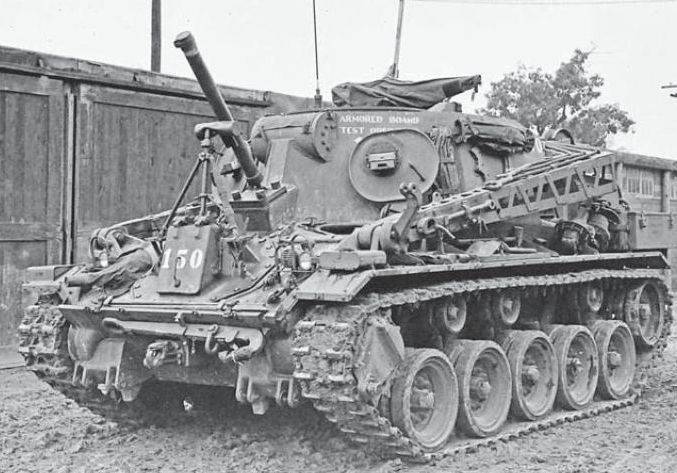
General view of BREM T6E1. Photo Aviarmor.net
Further success of the new projects showed no point in continuing to develop the T6 machine, and also demonstrated the need for further development of an alternative project. By order of 14 in October, the M6A5-based BREM T1 project was closed, and the development of the M24-based machine was to continue as T6E1. Under this name, a promising repair and recovery vehicle remained in stories American armored vehicles.
In accordance with the technical assignment, the armored recovery vehicle T6E1 had to carry a set of special equipment and tools to enable it to remove damaged armored vehicles of the corresponding weight from the battlefield, and then ensure that various repairs were carried out. The analysis showed that there is a fundamental opportunity to create a similar armored vehicle without major processing of the base chassis. There was a need to dismantle some units and install a large number of new ones, but significant reworking of the tank’s design, such as changing its layout, was not required.
This made it possible to use the chassis and hull of the Chaffee tank, the design of which, nevertheless, made certain changes. The hull, in general, retained its overall layout. In front of it, the transmission compartment remained, behind which the control compartment was located. At the site of the fighting compartment, it was proposed to place an inhabited compartment with a small workshop and some special equipment. Feed, as before, was given for the placement of the engine. Under the floor of the habitable compartment, a tunnel was kept for the drive shafts connecting the engine and transmission units.
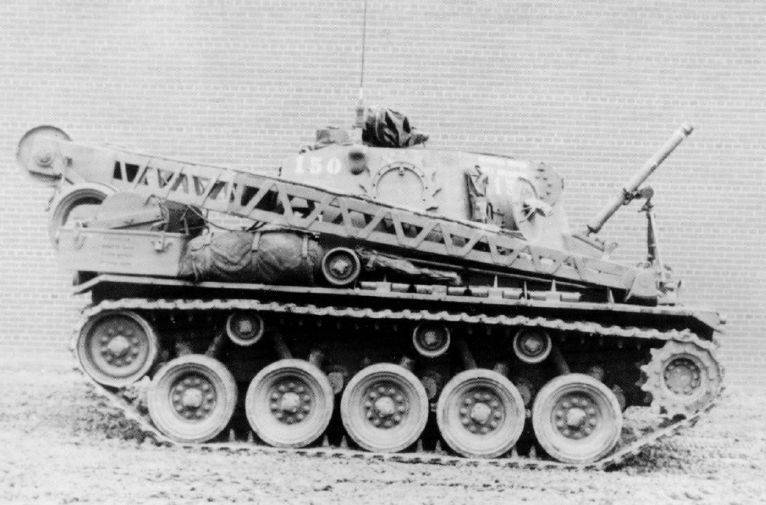
Side view. Photo Aviarmor.net
The power plant also remained the same. It was based on two Cadillac 44T24 petrol engines with an 110 horsepower rating. With the help of automatic transmissions, gearboxes, differentials and other equipment, driving wheels placed in front of the case were set in motion. The chassis has not undergone any changes. It still had to consist of five pairs of road wheels with a torsion bar, four of which were additionally reinforced with shock absorbers.
According to the new project, the hull had to undergo a noticeable rework, which was connected with the need to install a set of new equipment. As before, the body was proposed to be assembled by welding from rolled sheets and cast parts. The maximum thickness of the armor does not exceed 20-25 mm. To accommodate repairmen and a workshop with tools, it was decided to abandon the tower, replacing it with a large wheelhouse. The case was removed from the hull with a boxed box, instead of which they provided for a relatively large and long unit hexagonal in plan. The cabin had inclined front sheets, angled to the axis of the machine, and also equipped with relatively long sides and a vertical stern. Above, the crew covered the roof with a large round hatch without a cover.
The main task of the machine T6E1 was the evacuation of damaged equipment from the battlefield. To do this, she was able to tow various machines of the appropriate mass. Unlike later American or foreign BREM vehicles, the T6E1 did not have a traction winch to pull out stuck cars or pull them from a certain distance. For pulling and subsequent towing was proposed to use a rigid hitch. On the stern sheet, reinforcements were provided for towing rods, with the help of which other equipment should be hauled.
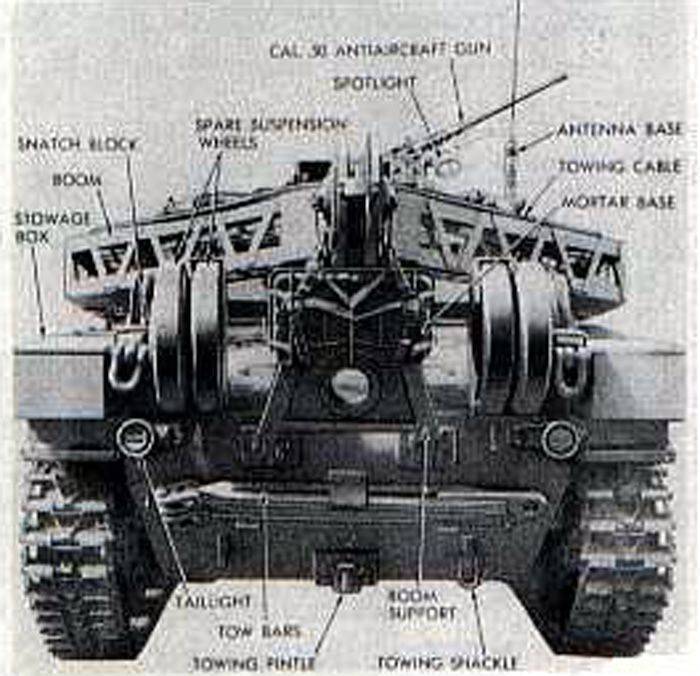
Back view. The boom in transport position, spare parts boxes, spare track rollers, towing devices, etc. are visible. Photo Hunnicutt RT Stuart. A History of the American Light Tank
For performance of various operations, first of all repair work, BREM T6E1 received a crane. Its main element was a large frame-shaped boom, made in the shape of the letter “A”. The lower elements of the boom were equipped with mounts, with the help of which they were pivotally mounted in the front part of the fenders of the chassis. At the top of the triangular part of the boom a block was provided for working with a cable. In the transport position, the boom was lowered onto the body by turning back. At the same time its triangular part was located above the roof of the engine compartment, and the hull cabin was located between the side supports. In addition, a special frame was provided on the hull's stern sheet, to which the boom was attached to prevent movement.
To carry out lifting work, the boom rose to a working inclined position, for which hand-operated mechanisms were used, placed near its anchorages on the body. In the working position, the boom was held with the help of several cables connecting it with the roof of the cabin. At the same time it was located with an inclination forward, so that the upper unit extends beyond the chassis. Directly for lifting goods offered a winch installed in front of the cabin. Through a special hatch in the roof and a block under it, the cable was extended to the boom block, and a hook was attached to it. According to reports, the winch could create an effort up to 60 thousand pounds (27,2 t), which allowed for a variety of operations. In particular, the T6E1 machine could participate in the replacement of the towers or powerplants of all US light tanks that were in service at the time.
Due to the specific balancing of the machine during carrying out of lifting work, opener outriggers were introduced into its design. Two comparatively narrow coulters were hinged on the front hull sheet, which should be lowered to the ground and fixed in that position before work. The presence of the coulters made it possible to change the distribution of the load on the undercarriage and thereby maintain an acceptable position of the BREM during work.
According to the project, the crew of the BRS T6E1 consisted of four people. The driver and his assistant were located in the office of management and had their own hatches. The commander and the mechanic were supposed to be in places inside the wheelhouse. In the course of evacuating and repairing damaged equipment, crew members were supposed to take on the duties of a locksmith, scaffold, crane operator, etc.
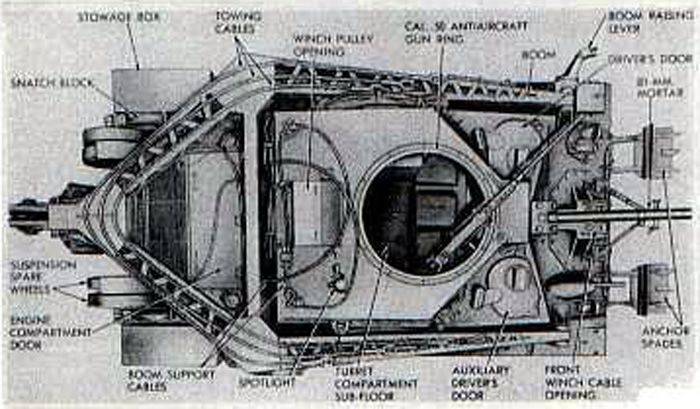
View from above. You can consider the design of booms, cuttings and other units. Photo Hunnicutt RT Stuart. A History of the American Light Tank
In particular, the crew members located in the cabin had to perform some repairs, for which a small workbench, racks for tools and parts, as well as other special equipment were provided for them. Due to this, the crew could carry out small repairs of various catches and aggregates in field conditions.
Some parts and spare parts were placed inside the cabin, while relatively large units were transported outside the hull. So, on the stern of the futon shelves two drawers for different property were provided. On the available photos, it is also clear that on the logging side mounts were installed for transporting the drive wheel of the M24 tank in a disassembled form. In the stern of the hull it was proposed to install mounts for the transport of two dual track rollers. Such parts allowed in the field to make some repairs to the undercarriage of Chaffee tanks or other equipment based on them.
It was assumed that the repair and recovery vehicle T6E1 will solve some problems directly at the forefront. Because of this, she needed protection and weapons for self-defense. In addition to the bulletproof booking of the hull, a new project offered a range of different weapons. On the logging hatch there was a turret with mounts for the M2HB heavy machine gun. In the front sheet of the case, in front of the workplace assistant driver, provided for the installation of machine gun rifle caliber.
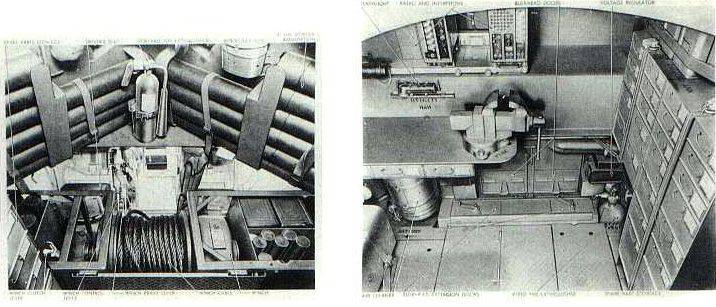
Interior felling when looking through a sunroof. On the left - the view ahead, on the right - the view of the stern. Photo Hunnicutt RT Stuart. A History of the American Light Tank
Perhaps the most interesting means of self-defense BREM T6E1 was a mortar mounted on the front of the hull. Between the driver and assistant hatches, it was proposed to mount a special metal block with a base plate for a mortar caliber 81 mm to the front sheets of the hull and deckhouse. In front of him, almost on the edge of the front sheet of the case, there was another block with attachments for bipods. The mortar was located on the longitudinal axis of the hull and was directed straight forward. Vertical guidance could be carried out using existing mechanisms, horizontal - by turning the whole machine. In ammunition of this weapons fragmentation and smoke mines were included, transported in special stowage in front of the cabin.
It was assumed that with the help of a mortar and mines with an appropriate charge, the crew of the BREM would be able to put smoke screens and thus cover themselves and the evacuated car, reducing the likelihood of an enemy attack. It was also possible to protect against enemy manpower with fragmentation mines, but such a use of weapons looks dubious and could hardly have had any noticeable effect. One of the reasons for this can be considered the impossibility of loading the mortar without going beyond the limits of the armored hull.
Dimensions of the T6E1 recovery vehicle stayed at about the level of the basic M24 tank, although the use of coulters and a crane resulted in some increase in the total length in the transport position. The combat weight of the machine was 41 thousand pounds - about 18,6 tons.
The assembly of an experienced BREM of the new type started only in 1944 year and lasted until the autumn. The manufacture of the prototype machine was assigned to Cadillac Motor Car Division, which built it on the basis of one of the serial tank chassis. September 5 prototype T6E1 arrived at the site for the necessary tests. Until the end of November, the car overcame various tracks, towed other vehicles and performed other tasks prescribed by the technical specifications. According to the results of inspections, it was recommended to modify the winch, crane and some other units, as well as to dismantle the mortar and course machine gun in the front sheet.
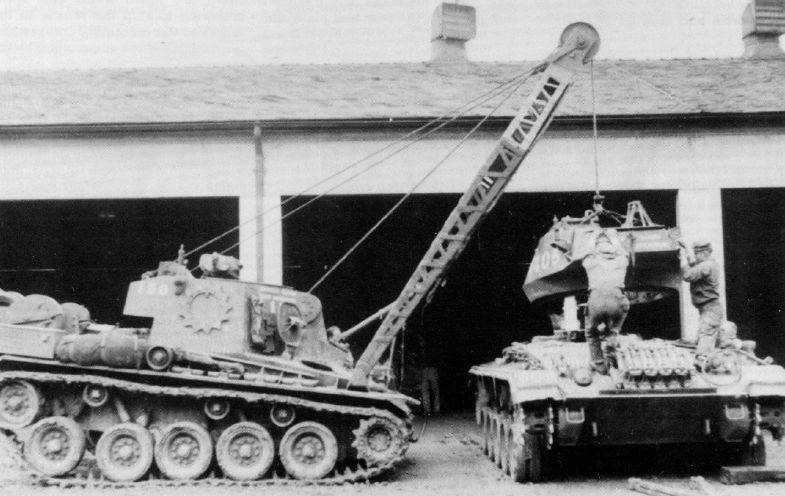
BRAM T6E1 participates in the repair of a light tank M24 Chaffee. Dismantling of the tower. Photo Aviarmor.net
On December 2, 1944, the T6E1 prototype was handed over to the American Car & Foundry Company, which was to finalize its design before the next stage of testing. As required, the mortar and one of the machine guns were removed from the vehicle. In addition, some of the remaining units were redesigned. In a modified form, the machine was supposed to enter new tests, but there is no information about their implementation.
According to reports, the T6E1 project was not completed until August 1945. By the end of the Second World War, experts were engaged in various works on the new BREM, because of which it was not ready for the start of mass production. As a result, the promising machine did not have time for the war, and its future prospects were a big question.
After the end of the war, a large number of projects that were once considered important and promising were closed as unnecessary. The development of an armored repair and recovery vehicle T6E1 added to this sad list. Major battles with the participation of light tanks M24 Chaffee were not planned in the near future, which is why the development of specialized BREM for them no longer made sense. The only prototype T6E1 was written off. Future projects of similar technology were based on newer base chassis with higher performance.
Based on:
http://m24chaffee.com/
http://aviarmor.net/
http://shushpanzer-ru.livejournal.com/
Hunnicutt RT Stuart. A History of the American Light Tank, Volume 1. Navato, CA. Presidio Press, 1992
Zaloga SJ M24 Chaffee Light Tank 1943-85. Osprey Publishing, 2003
Information